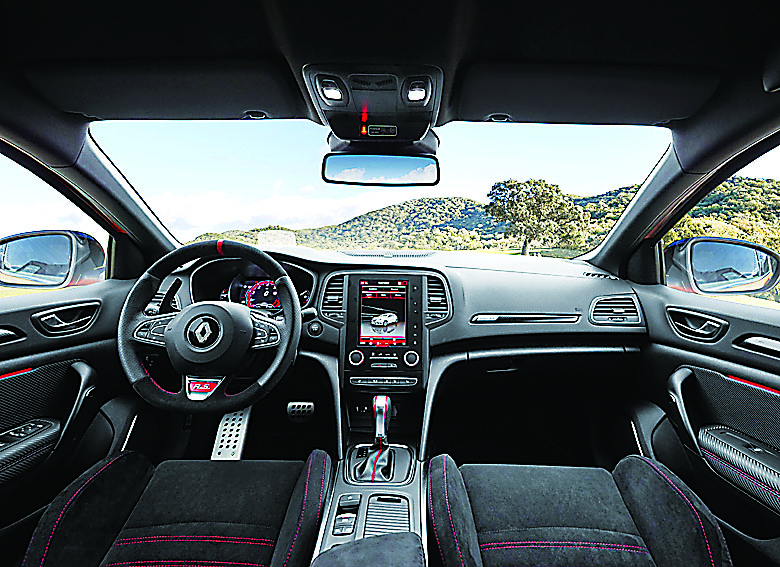There’s quite a lot going on underneath the Megane’s muscular styling. We’ve now got four-wheel steering, a powerful turbocharged engine and - enthusiasts rejoice - the choice of either a dual-clutch automatic or six-speed manual gearbox.
Renault says this model features more influence from its learning in motorsport than ever before. Engineers from the firm’s F1 team even helped with developing the Megane’s engine, ensuring it was as responsive as possible - despite being turbocharged.
The exterior has also been beefed up, as have the chassis and brakes. In all, it’s designed to be the most involving Megane R.S. yet. There’s the choice of either Sport or Cup chassis too, with the former more road-ready and the latter aimed at those who want to use their Megane on track.
The new Megane R.S. is powered by a 1.8-litre turbocharged petrol engine - the same as the one you’ll find in the Alpine A110 sports car. Here, it produces 280hp and 390Nm, which enables the Megane to hit 100km/h in 5.8 seconds before topping out at 250km/h. As we mentioned, two transmissions are available - a dual-clutch automatic or a six-speed manual. However, the biggest change comes elsewhere.
The new Megane now features all-wheel steering - a first for the hot-hatch segment. At speeds of up to 45km/h, both the front and rear wheels turn in the same direction, affording the car better high-speed stability. At low speed, they move in opposite directions, and this means the car can turn more sharply than with a conventional set-up.
A hot hatch needs to be sharp, nimble and, most of all, fun to drive. In most respects, the Megane R.S. ticks these boxes. The 1.8-litre engine feels punchy at low speeds yet has a willingness to be revved out too. It sounds characterful enough, though only when switched into all-out ‘Race’ driving mode - in regular modes, it’s pretty muted. The handling is sharp, with perhaps a little too much artificial weight added in racier modes, but the four-wheel steering does make the car particularly agile in the bends - and it’ll happily begin to rotate on a lifted throttle, but it never becomes scary or difficult to drive. There are some niggles, however - the gearshift paddles are mounted just slightly too high on the steering wheel, while the brake pedal lacks a degree of
bite under the first inches of travel.
Despite being based on a rather run-of-the-mill hatchback, the R.S. manages to look impressive in the metal. The arches have been fleshed out at both the front and rear, while small touches, such as air vents just behind the front wheels and a large hexagonal exhaust surround, help differentiate the R.S. from the regular Megane. Certainly, there were few people we passed while on our southern Spain test route who didn’t stop to stare - and that’s exactly the effect that hot hatches should have. The R.S. moniker has always been an indication of truly sporty cars, and enthusiasts instantly recognise the level of tuning and mechanical enhancement that it represents - a feature that can’t quickly be attained but has to be earned over time.

Those looking for a flamboyant, over-the-top interior may have to look in other directions than the Renault Megane R.S. For the most part, though, it’s a pleasant place to be - the sports seats are hugely comfortable with plenty of support and adjustment, while the seating position itself is spot-on. The materials throughout are decent enough, with only a few low-rent plastics on the dashboard and around the infotainment system spoiling the overall effect.
A hot hatch needs to be usable on a daily basis, after all, so it’s handy that the Megane R.S. features both decent rear-seat legroom and an impressively large boot. It means that those who plan on using their hot hatch every day - as they should be - won’t get caught short in terms of practicality.
The Megane R.S. benefits from quite a lot of standard equipment. Central to the cabin’s design is the large 8.7-inch infotainment screen, which houses satellite navigation and media functions. One of the cleverest functions it features is the RS Monitor. This allows drivers to connect a dash cam or smartphone to the system and film their laps on track. Then, the car’s in-board telemetrics can overlay details such as speed and G-reading on to the footage, which can then be uploaded to the internet. The screen itself looks good, but unfortunately small icons make it a little hard to navigate - and are particularly annoying when you’re trying to do something as simple as input a destination into the navigation.
The Megane R.S. is a little bit of a mixed bag. The engine, chassis and ride are all impressive. The 1.8-litre unit is responsive and pulls hard throughout the rev range, while the Sport chassis is just well judged enough for the road. However, a few niggles, such as the infotainment system and oddly placed gearshift paddles, do bring things down. That said, the Megane R.S. is still a huge amount of fun to drive - and that’s one of the key things you need with any hot hatch.









